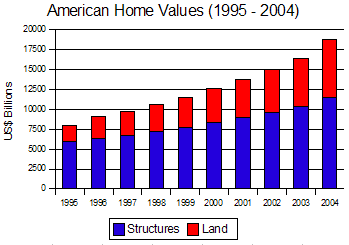Consequences: Rising Home Values, Land Costs, and Pension Benefits
Over the decade 1995 - 2004, the market value of residential real estate increased, on average, about 10% a year. (See: Federal Reserve Flow of Funds Table B100.)
The same table shows that the replacement cost of America’s homes, rose, on average, only about 7.6% a year.
If these estimates are reasonably correct, we can deduce that the value of the land on which American homes are built increased, on average, about 15.6% a year, over the decade.
The graph, drawn from this data, shows how overall residential real estate values changed over the period 1995 - 2004.
 American Homes: Land vs. Buildings
|
||
Over the decade, the imputed value of land as a percentage of total residential property values, rose from 25% to 38%. (Note: The imputed value of land is the market value of residential real estate less the cost of replacement of structures.)
Taking into consideration home equity values (market value less mortgages), land values increased from a 43% share to a 64% share, on average, of home equity values.
Since these figures represent averages for the entire nation, we may conclude that in some sections, land values are still around 20% of residential property values, whereas in other areas, land values may be higher than 60% of property values.
Consequences: Excessive Land Values
When the land portion becomes too high a percentage of property values, home owners are apt to ask questions like, “Why am I living in a tar-paper shack in New Jersey, when, for the same money, I could have a modern home, with four bedrooms and central air-conditioning in Georgia?”
Over the period 1995-2000, some states experienced high levels of emigration: New York, California, Connecticut, New Jersey, Massachusetts, and Illinois.
In fact, many states that classified as ‘blue states’ in the presidential election of 2000 (i.e., Democratic Party strongholds), were also net losers of population over the decade.
In the United States (Q3 2005), about 77% of personal taxes are imposed by the federal government. The remaining taxes are collected by state and local governments, largely in the form of taxes on residential real estate.
Whereas citizens cannot escape federal taxes, they can run from state and local taxes by moving to lower-tax areas — ‘voting with their feet’, as it were.
Where Property Values Are Likely to Collapse
Many of the large, older U.S. cities, like New York, Chicago, and Los Angeles, are controlled by the Democratic Party and their allies, the labor unions, which by now have been quite successful in unionizing local government employees and in obtaining generous pensions and high salaries.
The older the city, the greater the burden unionized public servants will be on local property values.
State and Local Government liabilities with pension funds (Q3 2005) totaled US$2.7 trillion, and this is probably understated
(See: “Why ‘Defined Benefits’ Pension Fund Managers Support Stock Buybacks“)
Now, here is the interesting thing about overly-generous local government pension plans:
The only way to cover the rising costs of pensions of local government employees is to raise taxes. It is politically inexpedient to cut pension benefits, as Governor Schwarzenegger learned in California. In many places, the number of public servants is so great as to make it virtually impossible to introduce reforms. (See: “Democracy’s Snare“)
As local property taxes rise, home owners have strong incentives to move elsewhere, thereby reducing the local tax base. Among those moving will be the pensioners themselves.
As property taxes rise and people leave for other states, wages must increase to match local living costs. Eventually, the economic climate is so bad and businesses leave in such numbers that the system implodes, real estate values fall and municipalities go bankrupt.
If the unions could produce dire results on American industry, turning large segments of the country into a ‘rust belt’, bankrupting whole industries, how can unionized municipal governments escape a similar fate?
So here are some guidelines in determining where the real estate bubble is likely to pop:
Areas that are losing population; and
Areas in which land values make up over two-thirds of residential property values; and
Areas that are controlled by the Democratic Party; and
Areas the have a high percentage of unionized public servants; and
Areas that are old, with an over-sized, aging, and over-paid public sector.
On the other hand, areas of the country with the opposite of each of these indicators — and there a many such places — are more likely to escape a collapse of real estate prices and may even benefit from the influx of immigrants from areas in economic difficulty.



























